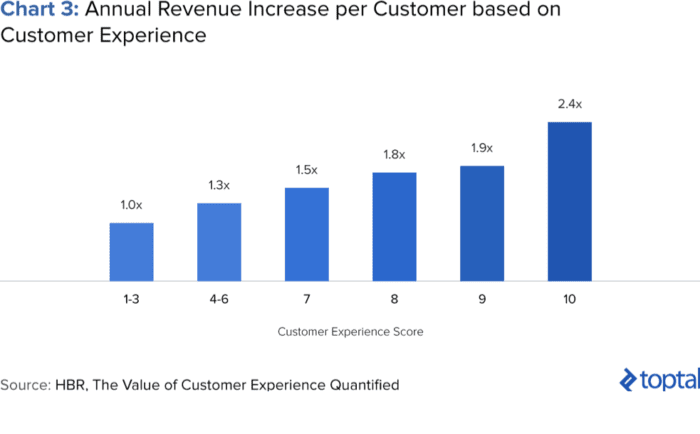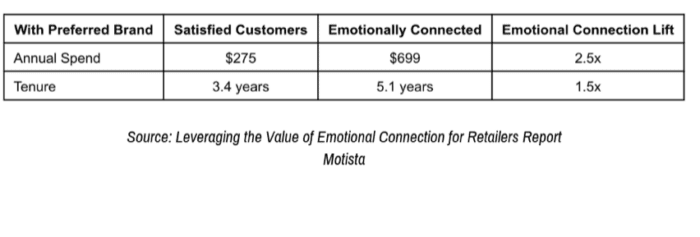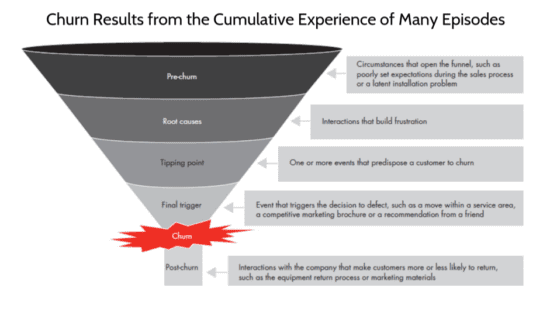Reducing customer churn is a powerful strategy. An HBR study found that positive customer experiences are associated with big increases in future revenue. But how do companies stop customer churn?
Customer churn is an expensive problem for businesses. Acquiring a new customer costs at least five times as much as retaining a current one. Meanwhile, existing customers are 60%-70% more likely to make a purchase than new customers. Chasing prospects costs businesses marketing dollars and sales.

Companies are better off spending their money trying to reduce churn by improving customer retention. Many businesses use tools like loyalty programs, customized email responses, or personalized thank you notes to make customers feel valued and important. A recent study by Motista showed that when customers have an emotional connection to a company, they have a more than 300% better lifetime value to the business.

But how do you find the right strategies to improve retention and reduce churn?
Focus on the data
All good business decisions start with data. Although emotional intuition or gut feelings can be important when deciding whether or not to pursue a particular course of action, data needs to be present. Without solid data, a “gut feeling” is just a guess.
Companies sometimes act as if it’s impossible to gain information from customers about their reasons for leaving. In fact, there are a wide variety of options, and a careful response to a customer’s exit may even help him or her stick around.
Here are some ways to collect information about churn:
- Offer a short survey if a customer is canceling an account or unsubscribing from an email list. This should be more than a simple "Will you tell us why you’re leaving?" but shouldn’t take more than a minute to complete.
- Call important customers whose sales are dropping off. Start by asking what’s happening, but also consider asking direct questions: Did you have a bad experience? Are you finding better pricing somewhere else? Companies should be clear that they want to know what’s happened so they can try to make it right.
- Follow up with customers who have gotten partway through on-boarding but then fallen off.
- Follow up via email for situations like a customer leaving a website with a full cart but no purchase. Offer the customer an opportunity to explain why he left.
- Use third-party data to test the ease of access to your website and the readability of email and social media.
Understand why customers are leaving
Once a company has collected data about why customers are either leaving or not completing their purchases, it’s time to analyze the data. Website design is a frequent issue. Failing to deliver on promises such as shipping times, return policies and service guarantees can also be problematic. Remember to look at more than just the most recent issue.
Download our Free Resource – 10 common website customer experience mistakes
This guide reveals examples of poor website design from different sectors which are commonly seen, but best avoided.
Access the
For example, when Bain & Company studied wireless providers, the firm found that CEOs tended to attribute churn to a superior offer from a competitor. But when looking at focus groups of wireless customers, Bain & Company heard stories of bad customer service over long periods of time, charges customers didn’t understand, or frequent error messages when trying to use their service. CEOs were trying to focus on the endpoint, but customers were leaving due to a chain reaction of poor service incidents that destroyed their loyalty and made switching providers an attempt to get better service.

This example shows how simply collecting data about the last event that went wrong isn’t enough. Companies should look for the pain points their customers are experiencing long before the customers decide to leave. This can be accomplished through several methods, including:
- Periodic attempts to retrieve feedback about how the last sale went.
- Offering brief satisfaction surveys after customer service interactions.
- Personal calls after completed sales, thanking customers for their business and asking about their experience.
- Taking feedback seriously. Not every customer complaint will change the course of a company’s service, but it’s crucial to watch for trends.
By looking for pain points throughout the entire sales process, the customer service experience will be improved and you’ll experience less churn.
Delight your customers
This catchphrase shows up in many articles and discussions about creating and maintaining customer loyalty, but it’s rarely explained. The words seem obvious: the meaning of delight is simply “great pleasure,” so delighting customers should be as simple as making their experience enjoyable. But companies need to look for new and original ways to do that. Delight is about more than freebies and coupons. These may not even be what customers want most.
For a long time, every loyalty program was a variation of the same thing: spend a certain amount of money and get a certain amount of credit. That transitioned into points-based rewards systems, where customers received something free or discounted when they’d accumulated enough points. In the B2B world, companies incentivized early invoice payments by offering discounts when invoices were paid before the due date. At one time, each of these opportunities delighted its recipients.
But once everyone is doing something, it’s just the standard. Businesses need to work to find new ways to delight their customers. Here are some ways to delight your customers:
Minimalism
Make all systems for interacting with your company simple and intuitive. Note that simple doesn’t mean simplistic. Minimalist web design can be very useful in certain ways; it can make a website more accessible by avoiding contrasting colours and overly complicated page structures. But if customers can’t find what they need, they’re going to get frustrated and find it somewhere else.
Include treats
When businesses think of offering free items to their customers, they often think of sending products and goods, sometimes branded with a company logo. While these are often good marketing tools, they aren’t necessarily great loyalty builders unless the item is functional and special. Instead, do something personal.
- Include a handwritten note on invoices, thanking customers for their business.
- Include a small bag of candy or healthy snack packs (depending on company culture) with the package
- Follow up a sale with a call to check and see how the customer is doing with your product.
Delighting customers is about making them feel cared for and relevant to your business. They want to feel like more than Invoice 924; showing them that you care about them and their business is an important step to doing so.
Importance of on-boarding
The importance of properly onboarding a customer cannot be overstressed. Every business should be aware of its sales funnel and how customers are moving through it. Obviously, not all customers will move from being prospects to sales, and there are many reasons why customers might eventually go somewhere else:
- The product doesn’t fit their needs.
- The price is too high for their budget.
- They decide to move in a different direction with their business.
But there are many other reasons that are preventable, which businesses should address. For example:
- Customers might not understand how to use the product or service.
- They might not understand the full functionality of the product.
- It isn’t clear how the product or service will benefit their business.
Every one of these problems can be mitigated with careful attention to the customer’s behaviour. For example, if a customer calls with detailed questions about a product but then doesn’t call back, reach out and find out what happened. If the customer isn’t sure what the product does or how it works, help the person understand. If it’s not working properly, provide support.
And if you truly want to delight a customer? When you realize that your product or service isn’t the right option for this particular customer, be willing to recommend something else, even if it’s offered by the competition. The customer will be so surprised and happy that he or she may well return when the original product is the correct one.
It's impossible for businesses to stop all customer churn, but given the cost of churn, it’s within your best interests to minimize it when possible. Look for chances to reduce friction points, support customers throughout the sale and afterward, and find ways to offer them something special. Build loyalty, and customers will stay.
Sam Meenasian has used his marketing, sales and operations expertise to build and grow
USA Business Insurance and BISU Insurance as co-founder and Vice President of Sales and Marketing Operations. USA Business Insurance has seen 130% to 160% revenue growth every year since its founding in 2007.









